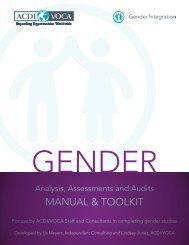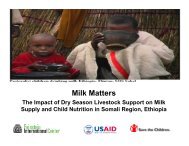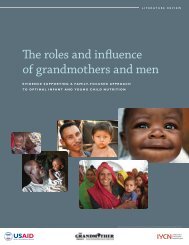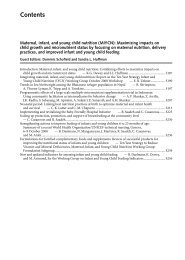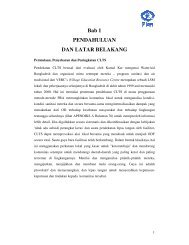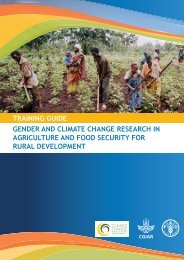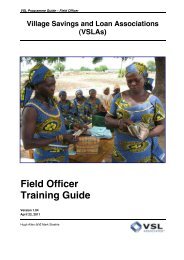Module 2. Theorethical Concepts of Gender - FSN Network Portal
Module 2. Theorethical Concepts of Gender - FSN Network Portal
Module 2. Theorethical Concepts of Gender - FSN Network Portal
Create successful ePaper yourself
Turn your PDF publications into a flip-book with our unique Google optimized e-Paper software.
Mainstreaming <strong>Gender</strong> into Water, Sanitation and Hygiene (WASH) Programs<br />
<strong>Module</strong> 2: Theoretical <strong>Concepts</strong> <strong>of</strong> <strong>Gender</strong><br />
Lesson 9: Different Approaches to <strong>Gender</strong> and Development: a Historical Understanding<br />
Handout 9.2<br />
Comparative Table on WID and GAD<br />
Issues Women In Development (WID) <strong>Gender</strong> And Development (GAD)<br />
Approach<br />
Origins<br />
Theoretical<br />
base<br />
Focus<br />
Problem<br />
WID is an approach that views<br />
women as a problem.<br />
WID emerged in the early 1970s<br />
encouraged, in part, by the<br />
publication <strong>of</strong> ‘Women’s Role in<br />
Economic Development’ by Ester<br />
Boserup.<br />
WID was linked with the<br />
modernisation theories <strong>of</strong> the<br />
1950s to 1970s. By the mid<br />
1970s, it was clear that the<br />
benefits <strong>of</strong> modernisation had not<br />
reached women and in some<br />
sectors had actually undermined<br />
their existing position.<br />
WID is focused on women.<br />
WID focuses on the need to<br />
integrate women into economic<br />
systems through necessary legal<br />
and administrative changes.<br />
Women’s productive role is<br />
emphasised and strategies<br />
developed to minimise their<br />
disadvantage.<br />
The exclusion <strong>of</strong> women (half <strong>of</strong><br />
the productive resources) from<br />
the development process.<br />
Contribution Women’s questions have<br />
become visible in the arena <strong>of</strong><br />
development theory and practice.<br />
Goal More efficient, effective<br />
development.<br />
Solution<br />
Integrate women into the existing<br />
development process.<br />
GAD is an approach to<br />
development.<br />
GAD emerged in the 1980s as a<br />
result <strong>of</strong> the failure <strong>of</strong> the WID<br />
approach to make significant<br />
changes for women.<br />
Influenced by radical feminist<br />
thinking, GAD was introduced to<br />
ensure development projects would<br />
have an equal share <strong>of</strong> decisionmaking,<br />
participation and benefits<br />
for both women and men.<br />
GAD focuses on relationships<br />
between men and women.<br />
GAD <strong>of</strong>fers a holistic perspective,<br />
looking at all aspects <strong>of</strong> men’s and<br />
women’s lives and relationships<br />
between them. It questions the<br />
basis <strong>of</strong> assigning specific gender<br />
roles to different sexes. It focuses<br />
on involving men in the process <strong>of</strong><br />
reducing gender inequality.<br />
Unequal relations <strong>of</strong> power (rich<br />
and poor, women and men) that<br />
prevents equitable development<br />
and women’s full participation.<br />
GAD does not exclusively<br />
emphasize women’s issues, and<br />
requires participation from men to<br />
achieve gender equality goals. It<br />
recognizes women’s and men’s<br />
contributions inside and outside the<br />
household, including noncommodity<br />
production and<br />
reproductive roles.<br />
Equitable, sustainable development<br />
with women and men as decision<br />
makers.<br />
Empower disadvantaged women<br />
and transform unequal relations.<br />
A Training Manual for Water Pr<strong>of</strong>essionals developed collaboratively by PROTOS and SNV, 01/02/2007<br />
<strong>2.</strong>59



